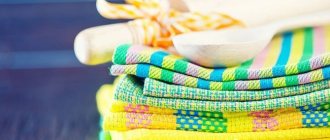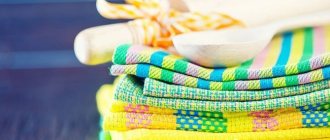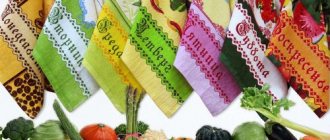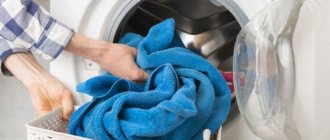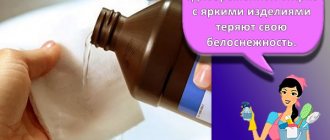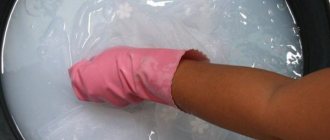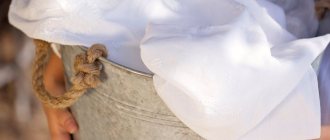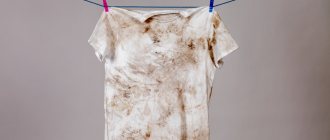The cleanliness of kitchen towels is the comfort of the kitchen, so every housewife dreams of inventing a way to return them to their original whiteness. Those who succeed do not keep their methods secret, but share them with others. The women's website "Beautiful and Successful" decided to collect the best whitening recipes on its page. If you are wondering how to bleach kitchen towels at home without boiling, read on. However, before we talk about bleaching without boiling, it’s worth telling why you can’t boil textiles and how to do it correctly if absolutely necessary.
How to prevent severe pollution
As they say, it is clean where there is no litter. This proverb is quite applicable to textiles. Preventing severe contamination is much easier than removing it. To make your kitchen towels less dirty, you need to:
- use waffle, linen or cotton fabrics - terry fabrics get more dirty and wash less well;
- wipe hands, dishes and cover pies with cloth napkins, and use non-woven materials for the table;
- wash more often to avoid dirt being absorbed into the fabric structure;
- use white textiles: dirt is more visible on it;
- Wash dishcloths separately from other laundry.
The problem is easier to prevent
Instead of looking for ways to effectively bleach a kitchen towel with old stains, you can try to avoid the need for such drastic measures.
If you take care of the cleanliness of the towels in advance, radical measures will not be required.
We have put together a list of recommendations for you that will help you keep your towels clean without much effort.:
- First of all, keep your towels in a place away from sources of pollution. Hooks on the wall are not a tribute to Soviet fashion, but a truly convenient way to keep textiles relatively clean.
- Think about how you use textiles . A white towel is not the best choice for wiping up spilled meat juices on the table or catching drips from the floor. For these purposes, it is better to get sponges and microfiber cloths.
- Is the towel dirty? This is a reason for urgent laundry. Don’t wait for the stain to set in: it’s easier to wash it fresh than to remove it for a long time.
- It is easier to bleach a white waffle towel than a terry towel. On the latter, dirt accumulates much faster. Therefore, give preference to the first option.
- After washing, be sure to iron the towel. This way the dirt will stick to it less. Oddly enough, this method really works.
As you can see, there is nothing particularly complicated in the recommendations for caring for towels. But what to do if some of them have persistent stains or the fabric has acquired an unpleasant shade? Let's figure it out now!
Soak
Bleaching will be more effective if the textiles are soaked before washing.
The following substances will help get rid of stains.
- Mustard powder. It requires 50 g per half liter of boiling water. The resulting mixture is diluted in hot water, the products are soaked overnight and then rinsed.
- Laundry soap. For 3 liters of warm water, half a block grated is enough. Grease stains should disappear within 5 hours, after which the fabrics should be washed.
- Turpentine. For 1 liter, take 1 tablespoon, leave for 8 hours, then rinse.
- Baking soda. Dilute 2-3 tablespoons in 1 liter of water, add a little essential oil. Soaking time – 3 hours.
- Hydrogen peroxide. A small amount is applied to the stain or dissolved in water. Wash after 40 minutes.
- Dishwashing liquid. With it you can soak towels directly in the sink for 1.5–2 hours.
- Ammonia . Dilute 5 tablespoons and 10 tablespoons of soda in 5 liters of warm water. In this case, it is enough to soak for 5 hours.
- Boric acid. It is used only for coarse waffle or cotton towels, as there is a danger of damaging lightweight fabrics. Two tablespoons diluted in five liters of water are designed to remove stains in 2 hours. Old stains will require repeating the procedure. Do not add bleach to the boric acid solution, otherwise streaks may appear.
Table vinegar
If a towel has been left for a long time, germs accumulate on it, causing a terrible musty smell. Even washing doesn’t always get rid of it, but vinegar will help. It creates an acidic environment in which microorganisms cannot survive:
- Pour 1.5 liters of very warm water into a basin.
- Add a faceted glass of vinegar. Take regular tableware, but not essence!
- Throw a towel in there to soak for 12 minutes.
- Then remove and rinse thoroughly in running water.
The smell will disappear, and it will be easier to wash kitchen towels from old greasy stains, since vinegar partially dissolves them.
Boiling
Today, this method is rarely used, but meanwhile, in addition to bleaching, boiling disinfects laundry, which is important in the kitchen.
My grandmother, who does not have a washing machine, almost never washes by hand: she first soaks all white fabrics, then boils them and rinses them. The effect is wonderful.
For boiling, choose enameled or stainless steel dishes with a volume of 5 liters or more, but the larger the better. The linen is removed with wooden tongs. Heavy stains must be removed before boiling, otherwise the stains will penetrate even deeper into the fabric.
Classic boiling lasts an hour or more, and then the laundry is infused for up to 12 hours.
Now remember how you can remove stains faster and without harm to the body.
- Just a few crystals of potassium permanganate added to the soap solution (20 g of soap shavings per 1 liter of water) will reduce the boiling time to half an hour.
- Silicate glue also helps remove stains faster. It is placed in a soap solution at the rate of 3 tablespoons per 10 liters of water.
- With soda (it is better to use soda ash) you can boil for only 10–15 minutes. A few tablespoons are added to the solution of powder or soap. Afterwards, the water is allowed to cool, and then the laundry is rinsed.
Silicate glue
How to bleach kitchen towels at home if other methods are powerless? Silicate glue from a regular office supply store works surprisingly well. You can also buy it at a construction store called “Liquid Glass”.
Add a spoonful of glue to 3 liters of boiling water and throw a towel in there. Let it fully dissolve and immerse the towel for 30-40 minutes. Then wash in the washing machine.
Bleaching in boiling water
If you don’t have the time or desire to boil, just bring the water to a boil and let it cool.
The following components will help remove stains and add whiteness.
Vegetable oil softens old stains well . 5 liters of water are heated to 100 degrees, add 2.5 tablespoons of oil, half a spoon of powder and 1 spoon of any bleach. After 12 hours, wash in a convenient way.
There is also this recipe: 20 ml of oil, 20 ml of Bos bleach, 50 ml of washing powder and 30 g of soda per 10-liter bucket of boiling water. A dirty cloth is placed in the water brought to a boil, after which the stove is turned off and the water is allowed to cool to room temperature.
Baking soda is also often used for bleaching . It can enhance the effect of vegetable oil by taking 1 tablespoon of oil, soda, bleach and powder per liter of water. The laundry is also left for 8–12 hours.
Another variation of the recipe is equal parts powder, soda and vinegar (30 g per 10 liters of boiling water) to dissolve stains for 8 hours, followed by machine washing at 70 degrees.
Hydrogen peroxide will deal with stains much faster. In 6 liters of water heated to 70 degrees, dissolve 2 tablespoons of peroxide and 1 spoon of ammonia. 20 minutes after soaking, rinse the laundry thoroughly.
Mustard powder fights dirt and grease well . Dissolve 5 tablespoons in 5 liters of hot water, let the solution brew and soak the towels for 5 hours.
To make stains come off easier, add some salt to the soaking (1 tablespoon per liter). Towels are placed in the solution for 5-6 hours, then washed in the machine. Also, salt at the rate of 1 tablespoon per liter of water is added when bleaching with peroxide and powder.
Edible lemon
Lemon is also an acid that effectively removes fatty residues. Before the procedure, you need to wash the towel with regular washing powder, and then:
- Sprinkle the powder generously onto the stains. It is better to take finely ground lemon or grind it yourself in a mortar - this way it will begin to react faster.
- Leave it for an hour to form a stable acidic environment.
- Then wash the item in running water. You can add soda to “quench” the remaining lemon juice.
Whitening in the microwave
This bleaching method is an express version of boiling and takes only 3-5 minutes.
The towels are moistened with water, rubbed with laundry soap, packed in a bag (no more than 3 pieces), but not tied, and placed in a microwave oven set to medium power. Then they wash it in the machine - the sooner the better.
In the same way, it is easy to bleach all cotton fabrics without a pattern.
Colored fabrics can be cleaned in the same way, but without heating them in the microwave: they are left in a bag overnight.
Potassium permangantsovka
If you have scarce potassium permanganate, try using it. It copes well not only with cleansing the stomach, but also textiles:
- First you need to wash your kitchen towels at home. Either with soap in a basin or in a machine with powder.
- Then take 4 liters of boiling water and dissolve a glass of powder there.
- Then add a little potassium permanganate. The color should be a pale pale pink, but not bright. Calcium permanganate not only whitens well, but also stains.
- Soak the towel for 2-3 hours and then rinse under running water.
Machine washable
Recommendations for machine washing towels are general.
- White and colored napkins are washed separately.
- Pre-washing will help remove stains.
- For colored fabrics, it is better to use oxygen bleach.
- White laundry can be washed well with baking soda (it can be poured both into the powder compartment and into the drum of the machine).
- To ensure that stains are removed, you need to wash with hot (70 degrees and above) water.
- The conditioner will perfectly refresh your laundry.
Hydrogen peroxide
Peroxide is a powerful oxidizing agent and solvent. It does a good job of removing greasy marks and yellowing on textiles, including old ones. Just wet the trail and forget about the towel for a few hours.
Installing a siphon under a kitchen sink with your own hands: assembly and connection diagramHow to wash a suspended ceiling so it looks like new
The most interesting and useful little things for your kitchen
By the way, peroxide has a “big brother” - a cosmetic hair oxidizer. You need to work with it more carefully, but the efficiency is also higher.
Important, the oxidizing agent is EXCLUSIVELY suitable for light-colored towels. On colored people it will leave noticeable white spots.
Recommendations for caring for terry towels
I would also like to say something about terry towels. After repeated use, they not only become dirty, but also hard. This happens because dirt accumulates in the loops, and during washing, particles of detergent also accumulate. It is more difficult to care for such fabric than smooth fabric. But if you follow simple rules, towels will last longer.
- Terry does not like either excessive dryness or high humidity. If you leave napkins wet, they may develop not only an unpleasant odor, but also mold. Therefore, it is better to wash them immediately after soiling. And under no circumstances should you leave it in the laundry basket: lint absorbs odors very well.
- It is better to wash terry fabrics by hand without alkali and chlorine - preferably with laundry soap or bleaching shampoo (as a rule, soap contains already processed alkali). The powder will be difficult to wash out of the fibers.
- Baking soda and vinegar will help remove stubborn dirt. Baking soda is poured into the drum, and vinegar is poured into the powder hole to soften the water. It is especially important to soften the water when washing terry.
- It is advisable to wash items separately from other laundry and do not fill the drum to the limit.
- An additional rinse will help keep the fabric fresh. Terry washes well only in a large amount of water, and therefore using express washing is not recommended for it.
- Drying terry towels near heating appliances is also not worth it.
Zelenka
Brilliant green is a good dye that can be used to hide faded yellowness. To do this, wash the towel in the washing machine as usual, and then prepare the bleaching medium:
- Dissolve 5-8 drops of brilliant green in 4 liters of water.
- Submerge the towel there for 90 minutes.
- Wash it in the washing machine again.
The yellowness will be replaced by white with a barely noticeable green tint. By the way, bluing works the same way.
The best household chemicals
The leading brands of bleaches are:
- Vanish Oxi Action. The product has an average price; Available in powder and gel form, and does not contain chlorine.
- Synergetic. Inexpensive but effective product in the form of a gel.
- Amway. Liquid chemicals for bleaching fabrics, produced by an American company. Expensive, but high quality product.
- Dr. Beckmann. German whitening powder removes stains of various origins and does not contain aggressive compounds.
If you have any difficulties choosing a product, you can contact your sales consultant for help. It is worth noting that it is easier to order some household chemicals online.
Drying rules
Bleached kitchen towels are dried well before use.
The moisture remaining in the fibers is a favorable environment for the growth of bacteria. At best, the product will begin to smell unpleasant, at worst, it will become a source of infection.
Items made of microfiber and terry should not be dried in direct sunlight or ironed. In the first case, high temperatures will lead to deformation of the product and a decrease in its ability to absorb. Ironing terry towels causes them to become thinner and wear out prematurely. For other types of fabrics, drying in the open air plus steaming with an iron is preferable.
Textiles made from thin natural fabrics are the easiest to wash. However, due to intensive use they wear out quickly. Synthetics and terry are better at absorbing moisture, but are more difficult to maintain. Therefore, when choosing a method for bleaching a kitchen towel, you need to study the type of fabric and the manufacturer’s recommendations for washing.
"Fairy"
Old greasy stains can be easily removed with Fairy and similar products. They are emulsifiers and easily bind fat to water.
Apply the product to the stain and leave for a day. Then wash in the machine without washing off the Fairy. But it’s better not to wash other things at this moment. It can cause allergies upon contact with the skin, since it is not completely washed out.
With normal loss of color, yellowing or “graying”, Fairy fabric is not suitable. The product only works well on greasy stains.
How do you like the article?
Borax
Boric acid (borax) also works well against traces of fat and gray-yellow coating. It should be used in a ratio of 2 tbsp/4 l of hot water.
Soak the towel in a bowl of solution for 30 minutes and then inspect. If the marks have not disappeared, repeat the process until the stains are gone.
Boric acid is not compatible with terry fabrics.
Why do kitchen towels need to be washed frequently?
Many processes are carried out in the kitchen every day: cutting fish or meat products, preparing first and second courses, kneading dough. Frequently wiping your hands on a cloth not only pollutes it, but also “colonizes” it with bacteria and harmful organisms. If you rinse a towel less often than once every 3-4 days, E. coli can settle on it. Such microorganisms can cause severe intoxication. Some of their strains have even developed immunity to antibiotics.
Wash your kitchen towels more often!
The bacterium lives on any kitchen surface, but its favorite place is the towel. The author of the study, Charles Gerba, claims that after “dirty” cutting work, a person does not wash his hands very thoroughly, and when wiping them, he leaves some of the microflora on the fabric. It is enough to use the towel again to be in the path of infection with the wand.
Advice! Replace cloth napkins with disposable ones made of paper - this will maintain hygiene and simplify the washing process. Disadvantage: financial costs will increase.
